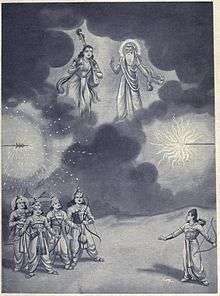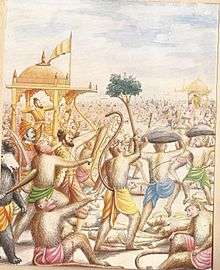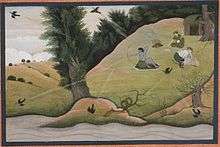Brahmastra
In ancient Indian history, the Brahmastra (Sanskrit: ब्रह्मास्त्र, IAST: Brahmāstra) and its variants, the Brahmashirsha astra and the Brahmanda astra were supernatural weapons used in the war of Mahabharata and are collectively called Brahma weapons. The Brahmashirsha astra was a weapon that was said to be able to destroy the world, capable of destroying creation and vanquishing all beings. It is one of the most destructive, powerful and irresistible weapons mentioned in Hinduism. These weapons are all created by Lord Brahma, except for brahmanda-astra.
It is termed as a fiery weapon that creates a fierce fireball,[1] blazing up with terrible flames and countless horrendous thunder flashes. When discharged, all nature including trees, oceans, and animals tremble, and the sky surrounds with flame, glaciers melt and mountains shatter with copious noise all around.
When struck, it causes complete destruction to each and every resource of that area, further not a single blade of grass will ever grow in that area. There will be no rainfall for 12 divine years (4320 years) and climate condition will worsen. The strike of Brahmastra will eventually destroy everything.
Variants
Brahmashira Astra

The Brahmashira Astra (Brahma's head weapon),[2] manifests with 4 heads of brahma at the front and is 4 times stronger than the normal brahmastra.[3] Brahmanda Astra is a weapon that manifests with the fifth head of Brahma at the front. It is a weapon that was capable of destroying the world.[4] Arjuna and Ashwatthama almost used the astra against each other near the end of the Kurukshetra War, however both were stopped by Narada and Vyasa to prevent the destruction of the world.
Uses
There are numerous instances within Sanskrit theological scriptures where the Brahmastra is used or its use is threatened, including:
- Maharaja Kaushika (who later became Brahmarshi Vishvamitra) used it against Maharishi Vasishta, but the Brahmastra was swallowed by Vasishta's Brahmadanda Astra.
- Indrajit used the nagasthira against the army of Rama in the Ramayana. Lakhsmana was injured by this weapon only. Only the Sanjeevani herbs brought by Hanuman managed to save the brothers and their army from death. Also, Indrajit used the Brahmastra against Hanuman, but Hanuman survived because of the boon previously given to him by Lord Brahma.
- In the Ramayana, a Brahmastra is used by Shri Rama several times: once against Jayanta when he hurt Sita, against Mareecha in their last encounter, and finally the Brahmastra was used in the last battle with the Asura emperor Ravana.[5] According to the Ramayana, the weapon was also aimed at Varuna to carve a path out of the sea such that Rama's army could march towards the island of Lanka. However, as Rama loaded the weapon, Varuna appeared and offered to assist the king in crossing the ocean. But once invoked, the Brahmastra must be discharged, and hence it was instead aimed towards Dhrumatulya, falling at of modern-day Rajasthan, causing it to become a desert for eons to come. However, this incidence is not mentioned in Valmiki Ramayana.
 Killing of Ravana Painting by Balasaheb Pant Pratinidhi
Killing of Ravana Painting by Balasaheb Pant Pratinidhi Rama Pursues Kakasura with a Magical Grass-Arrow
Rama Pursues Kakasura with a Magical Grass-Arrow
See also
- Sanskrit Epics
- Ramayana
- Mahabharata
- Puranas
- Brahma
- Brahmani
- Vyuha
References
- Krishnamoorthy, K.; Channakeshava, B.; Rao, H. V. Nagaraja (1995). Ānanda Bhāratī: Dr. K. Krishnamoorthy Felicitation Volume. Dr. K. Krishnamoorthy Felicitation Committee.
- Maehle, Gregor (2009). Ashtanga Yoga: Mythology, Anatomy, and Practice. New World Library. ISBN 9781577316695.
- "Brahmaśiras - Oxford Reference". doi:10.1093/acref/9780198610250.001.0001/acref-9780198610250-e-542. Cite journal requires
|journal=(help) - "The Mahabharata, Book 10: Sauptika Parva: Section 12". www.sacred-texts.com.
- Gopal, Madan (1990). K.S. Gautam (ed.). India through the ages. Publication Division, Ministry of Information and Broadcasting, Government of India. p. 80.
